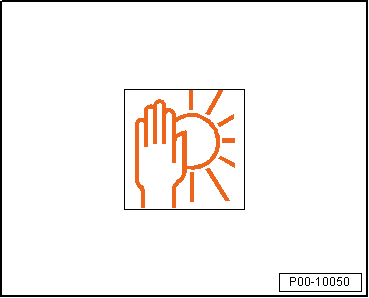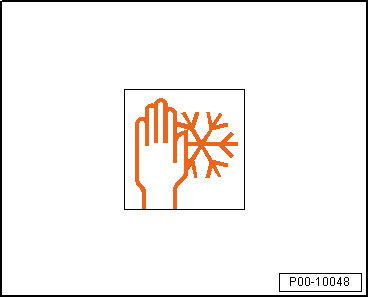Volkswagen Polo Service & Repair Manual: Long-Term Underbody Protection -D 314 D37 M2-, Black
| Long-Term Underbody Protection -D 314 D37 M2-, Black |
| Product description of Long-Term Underbody Protection -D 314
D37 M2-, Black |
| Long-Term Underbody Protection -D 314 D367 M2- is a black
coating compound with a watery synthetic dispersion base that is
sprayed with a UBS gun. |
| The drying time depends on the layer thickness, ambient
temperature and the surrounding humidity. Good ventilation and
higher temperatures quicken the drying time. |
| The dried film shows good adhesion to galvanized and
cathodic primed steel panels, as well as painted base surfaces.
Due to the high resistance to abrasion and low-temperature
flexibility, the long-term underbody protection is characterized
by its quality stone chip protection characteristics. |
| The long-term underbody protection can be quickly painted
over with water-based paints. |
| After air drying (approximately two to three hours), the
material can also be painted over with conventional painting
systems (contains solvents). |
| The dried coat sands easily after hardening. |
| The long-term underbody protection is used to reestablish
the original structure after a repair. |
| The material is only temporarily resistant to gasoline and
cold cleaners. |
| Long-Term Underbody Protection -D 314 D37 M2- is suited for
repair work on the underbody, wheel housing, front and rear
areas. It is used on visible components, such as on the side
sill, as paintable protection against stone impact, road salt
and moisture corrosion. |
| The material is used to reestablish different surface
structures on vehicles of all types after a repair. |
| The long-term underbody protection is suitable for dampening
the sound of luggage compartments, hoods, wheel housings, and
side panels as well as covering and sealing repaired surfaces,
welded joints and overlaps. |
 Note Note
| Before starting to apply, it is necessary to read the safety
measures and advice in the safety data sheet. |
| Even for products which are not required to be labeled by
law, the usual safety measures must be observed for chemical
emissions. |
| Clean the surfaces to be treated well beforehand and remove
any rust. |
| The surfaces must be free from dirt and dust, dry and
grease-free. |
| Surfaces which are not to be coated should be covered with
paper. |
| Bare steel surfaces are to be primed before applying the
long-term underbody protection. |
| The long-term underbody protection is applied from the 1 L
can using the UBS spray gun. The application pressure is 4 to 5
bar. |
| Shake the can contents vigorously for one minute before
using. |
 Caution
Caution
| Do not spray onto the steering, engine, driveshaft,
exhaust, catalytic converter and brake systems. |
| Blow out the spraygun immediately after use and then
rinse it with Plastic Cleaner -D 195 850 A1-. |
| If the spray gun becomes blocked the can may burst! |
| Observe the operating instructions of the UBS spray
gun! |
|
 Note Note
| The long-term underbody protection can be painted over with
water-based and solvent-containing paints. Due to the large
number of available systems on the market, testing is necessary. |
| 1 - |
Painting over with water-soluble paints: |
| – |
After a short drying period (matte surface), the long-term
underbody protection can be painted over up to 72 hours after
applying with water-soluble paints. |
| 2 - |
Painting over with conventional (solvent-containing) paints: |
| – |
After drying, the long-term underbody protection can be
painted over up to 72 hours after applying with conventional
(solvent-containing) paints. The material has a quick-drying
thick layer system. If accelerating the drying period in an
airflow, then make sure that the rapidly forming film is not
being actively blown onto the material that is still drying.
This could lead to crack formation. |
| Splashes on painted surfaces should be removed immediately
using Plastic Cleaner -D 195 850 A1-. |
| Equipment or the dirty parts of the equipment should be
cleaned after applying water, and if necessary, adding of a
watery cleaner. Do no use any solvent-containing cleaners
(clotting). After drying, the long-term underbody protection can
only be removed using a tool. |
|
|
|
|
Technical Data: |
| Color |
Black |
| Odor |
slightly like ammonia |
| Density |
approximately 1.22 g/cm³ |
| Solid matter content |
approximately 67 % |
| Viscosity: |
0.5 Pas |
| Measuring
instrument |
Physica |
| Measuring
system |
Z 4 |
| Wet application thickness |
1 mm |
| Thinner/cleaner |
distilled water |
| Processing temperature |
+10 °C to +25 °C (50° to
77 °F) |
| Application temperature |
-25 °C to +80 °C (-13° to
176 °F) (short-term, up to one hour at +100 °C (212 °F)) |
|
Acoustic data: |
| Dissipation
factor DIN 53440 |
Approximately 0.10 |
| Temperature |
+20 °C (68
°F) |
| Frequency |
200 Hz |
| Material |
1 mm steel
panel |
| Coating to panel
thickness ratio |
2:1 |
| The guaranteed shelf life is 12 months from the production
date. Use no later than the date indicated on the label and
store in original container at +20 °C (68 °F). |
|
|

|
| The recommended storage temperature for the long-term
underbody protection is +10 °C to +25 °C (50° to 77 °F). |
| The long-term underbody protection is vulnerable to frost.
It must not fall below +5 °C (41 °F) |
|
|

|
Definition:
Long-Term Underbody Protection -D 314 D36 M2-, Gray
Edition 02/2010
Product description of ...
Definition:
Long-Term Underbody Protection -D 314 D38 M2-, Bright Color
Edition 02/2010
Product Descrip ...
Other materials:
Checklist
Using seat belts :
Check the condition of all seat belts regularly.
Keep the seat belts clean.
Avoid allowing any foreign bodies or fluids
to get on to the seat belt or latch plate or into the slot for the seat belt
buckle.
Do not trap or damage the seat belt and
latch ...
Valve, Removing and Installing, Metal Valve
Special tools and workshop equipment
required
Torque Wrench -VAG1410-
Perform the Following:
Removing
–
Remove the Tire Pressure Monitoring Sensor. Refer to
...
Battery, Checking
General Information
WARNING
Risk of injury. Follow all Warnings and Safety
Precautions. Refer to
→ Chapter „Warnings and Safety Precautions“.
...
© 2016-2025 Copyright www.vwpolo.net

 Note
Note Note
Note Long-Term Underbody Protection -D 314 D36 M2-, Gray
Long-Term Underbody Protection -D 314 D36 M2-, Gray Long-Term Underbody Protection -D 314 D38 M2-, Bright Color
Long-Term Underbody Protection -D 314 D38 M2-, Bright Color
 Caution
Caution
